February 3 - 9, 2013: Issue 96
Church Point Wharf
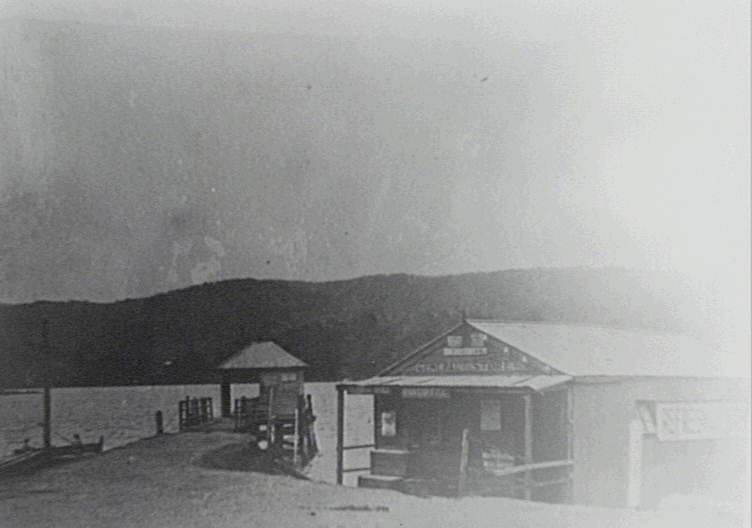 Church Point, like any rural setting, was home to only a handful of families who occupied the isthmus of Church Point, further along McCarr’s creek and its offshore headlands. These families had children who were required by Government decree to be educated. Pittwater children needed a school and once a room such as the now demolished Wesleyan church, for which Chapel Point and then Church Point (1888) was named, began to be utilised during the week as a school in1881. A means to get children from all parts of the estuary to there and land them safely also became necessary. In an area that was visited by steamers only once and then twice a week, owning your own vessel was vital due to the condition of tracks called ‘roads’, as were safe jetties and wharves where little legs and arms are concerned.
Church Point, like any rural setting, was home to only a handful of families who occupied the isthmus of Church Point, further along McCarr’s creek and its offshore headlands. These families had children who were required by Government decree to be educated. Pittwater children needed a school and once a room such as the now demolished Wesleyan church, for which Chapel Point and then Church Point (1888) was named, began to be utilised during the week as a school in1881. A means to get children from all parts of the estuary to there and land them safely also became necessary. In an area that was visited by steamers only once and then twice a week, owning your own vessel was vital due to the condition of tracks called ‘roads’, as were safe jetties and wharves where little legs and arms are concerned.
The word wharf comes from the Old English hwearf, meaning 'bank' or 'shore', and its plural is either wharfs or wharves; collectively a group of these is referred to as a wharfing or wharfage. 'Wharfage' also refers to a fee ports impose on ships against the amount of cargo handled there. In Pittwater our research shows many of these structures were also defined under the term ‘jetty’ and these were and are either; 1. A landing stage or small pier at which boats can dock or be moored or 2. A breakwater constructed to protect or defend a harbor, stretch of coast, or riverbank. A wharf was a larger more stolid structure out into deeper water that could accommodate larger vessels requiring such stations to be able to tie up to.
On June 1st 1883, the Mayor of St Leonards, the District where so many births in Pittwater are recorded during the 1800’s, prevailed on the then Colonial Secretary of the colony for a wharf. The response is recorded:
DEPUTATIONS. THE NARRABEEN-ROAD.
A deputation, consisting of the Mayor of St Leonards, Dr Tibbit's, and several other gentlemen, waited upon the Hon. Alexander Stuart, Colonial Secretary, yesterday, to request that the Narrabeen-road from Manly to Pittwater be put in a proper state of repair, and that a jetty be constructed on Church Point at Bayview, Newport. The road, it was represented, is now in a very bad condition, and if it were put into proper order it would open up one of the most beautiful districts in the colony. The jetty was required for the benefit of children going to school and persons attending church. The deputation also asked for a bathing place.
Mr. Stuart said he was quite aware that the road had been in a very bad condition, but it was gradually, perhaps rather too slowly being made, and as soon as a bridge was carried across s Narrabeen the work on the other side must follow in a matter of course. He would give instructions to have the road examined specially, and reported upon to him during the ensuing week, and he would take an opportunity of visiting the locality and seeing what further could be done in the what further could be done in the way of relief. In regard to the jetty he would give the matter consideration but while the Government might erect a wharf he thought the inhabitants ought to construct a bathing place. The next thing likely to be wanted by the residents would be that the Government should go and wash them. DEPUTATIONS. THE NARRABEEN-ROAD. (1883, June 2). The Sydney Morning Herald (NSW : 1842 - 1954), p. 9. Retrieved from http://nla.gov.au/nla.news-article13536041
{Dr. Tibbits of Petersham, a medical practitioner, is the landholder of 40 acres, part of Portion 25, on the west side of the ‘church acre’.} (1.)
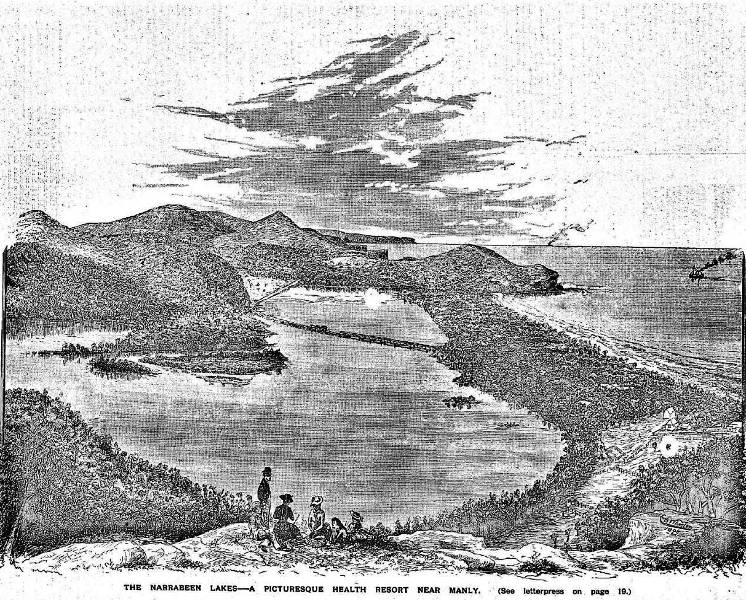
View of Narrabeen Lake from November 11, 1893, Australian Town and Country Journal
It seemed as though it still took a while to move things along unless you glance at the lapse between a Tender being announced and a person being accepted for the work;
THE following tenders were opened by the Tender Board at the Public Works Department yesterday: Wharf at Church Point, Pittwater. NEWS OF THE DAY. (1884, December 10). The Sydney Morning Herald (NSW : 1842 - 1954), p. 9. Retrieved from http://nla.gov.au/nla.news-article13581494
Accepted tenders: William Boulton, construction of wharf at Church Point, Pittwater. GOVERNMENT GAZETTE. (1884, December 31). The Sydney Morning Herald (NSW : 1842 - 1954), p. 6. Retrieved from http://nla.gov.au/nla.news-article13578833
The completion of the Government wharf at Church Point, Pitt water, will prove a great benefit to the residents in that district. The wharf is a substantial wooden structure, and boats drawing 11 feet of water will be able to come alongside at high tide. The population in the neighbourhood of Pittwater is rapidly increasing, and it is understood that the Government intend building a Public school to accommodate 50 pupils. Fruit-growing promises to be the leading industry in that locality. A considerable area of land is being planted with fruit trees. NEWS OF THE DAY. (1885, July 4). The Sydney Morning Herald (NSW : 1842 - 1954), p. 11. Retrieved from http://nla.gov.au/nla.news-article13592258
Bay View, later defined by perimeters into Bayview and Church Point, was essentially a hub of Pittwater in her early days. The Church Point wharf was where goods were offloaded and produce loaded for carrying to Sydney along the coast or, more often, back up the Hawkesbury River. It is where people would catch steamers to elsewhere, buy goods, receive telegraphs or land to go to the Turimetta township, later to be Mona Vale. if a steamer only brought news of the outside world once or twice a week, it was also a place to gather for such events.
Pioneers like Robert McIntosh, who is listed in the 1815-1824 Government Gazette notices as ‘1817 Oct , On list of free settlers who are to receive land immediately; at Pittwater (Fiche 3266; 9/2652 p.40) and then again at 1819 Jun 5 Appointed constable in districts of Pitt Water and North Harbour (Reel 6038; SZ1044 p.52), before a stint in prison, fattened cattle and cleared pristine bush to grow produce. The people were hard working, feisty and not given to putting up with interlopers coming into their fields and waterways and helping themselves:
METROPOLITAN DISTRICT COURT. Wednesday. In this case John Summersgill, of Albert-street, Redfcrn, sued George Brown, of Church Point, Pittwater, for £200 damages for wrongful seizure, verdict for the defendant, without costs. METROPOLITAN DISTRICT COURT. (1892, May 26). The Sydney Morning Herald (NSW : 1842 - 1954), p. 3. Retrieved from http://nla.gov.au/nla.news-article13868674
Church Point, alike Newport on its opposite shore, was a garden of fruit and fish. A wharf was vital for transporting;
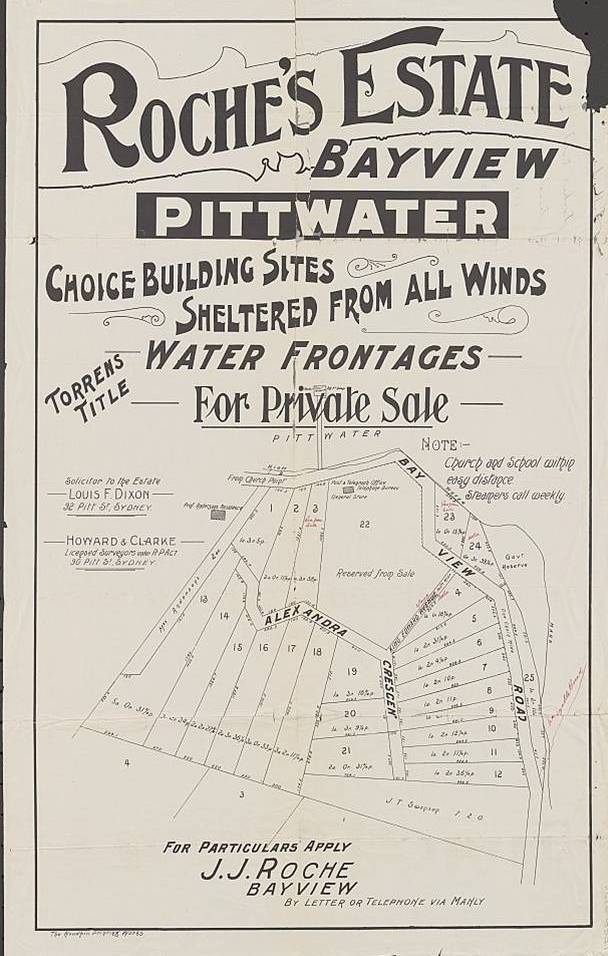 At length the Rock Lily Hotel is reached, and here is refreshment for man and beast. A few yards beyond here the road branches, one to the town of Newport and Barrenjoey Lighthouse, and the other to Bay View Post Office and Telephone Office and Church Point. At Bay View the expansive waters of Pittwater and Broken Bay in all their glory lie disclosed to view. Our illustration gives a very good idea of the scene. In the foreground is Bay View House, vine yard, orchard, Post and Telegraph Office, the property of Mr. J. J. Roche. In the near view is Pittwater, extending its broad and deep arms to the right and to the left, and in the distance is Broken Bay, with Lion Island barring the passage way, so named because of its resemblance to a lion couchant. Only half the scene described is represented in the picture, but the varied panorama of headland jutting out beyond headland, with the intervening bays and arms as they sweep inward between the wooded head lands, gives a good idea of what the other side is like. Broken Bay is, as is well known, one of the most magnificent harbors in Australia, with plenty of deep water and ample scope for the largest ships that sail the ocean. Its vicinity to Port Jackson has, up to the present, destroyed its chances of becoming a commercial centre, but no one can doubt that the day will come when it will be the seat of a prosperous population with cities and towns within its borders, and railroads and ships bringing goods to its marts. At present it is merely used as a haven of shelter by storm-tossed ships, yachting parties, and an occasional excursion steamer from Sydney. At present its population is mostly composed of private gentlemen, who have residences among its beauty spots, the summer residences of business men from the metropolis, a few professional fruit-growers, with a scattering of business men and fishermen.
At length the Rock Lily Hotel is reached, and here is refreshment for man and beast. A few yards beyond here the road branches, one to the town of Newport and Barrenjoey Lighthouse, and the other to Bay View Post Office and Telephone Office and Church Point. At Bay View the expansive waters of Pittwater and Broken Bay in all their glory lie disclosed to view. Our illustration gives a very good idea of the scene. In the foreground is Bay View House, vine yard, orchard, Post and Telegraph Office, the property of Mr. J. J. Roche. In the near view is Pittwater, extending its broad and deep arms to the right and to the left, and in the distance is Broken Bay, with Lion Island barring the passage way, so named because of its resemblance to a lion couchant. Only half the scene described is represented in the picture, but the varied panorama of headland jutting out beyond headland, with the intervening bays and arms as they sweep inward between the wooded head lands, gives a good idea of what the other side is like. Broken Bay is, as is well known, one of the most magnificent harbors in Australia, with plenty of deep water and ample scope for the largest ships that sail the ocean. Its vicinity to Port Jackson has, up to the present, destroyed its chances of becoming a commercial centre, but no one can doubt that the day will come when it will be the seat of a prosperous population with cities and towns within its borders, and railroads and ships bringing goods to its marts. At present it is merely used as a haven of shelter by storm-tossed ships, yachting parties, and an occasional excursion steamer from Sydney. At present its population is mostly composed of private gentlemen, who have residences among its beauty spots, the summer residences of business men from the metropolis, a few professional fruit-growers, with a scattering of business men and fishermen.
From Bay View the road, a very good one, winds around the beach, disclosing as every vantage point is gained new beauties of land and water. Around here are some very good orchards, with trees laden with fruit, and the homesteads peeping out from masses of evergreen foliage, with an extensive vista of land and water. In a charming spot on a sloping hillside, with such a fore ground and a craggy background Professor Anderson Stuart has a summer residence and orchard. Mr. W. G. Geddis (spelt Geddes elsewhere) has a neat residence on a pleasant point. Mr. W. Baker has an orchard with some magnificent trees, while on a commanding bluff is Mr. John Poster's residence and orchard. Mr. A. McIntosh's residence is also hard by.
This road ends at Church Point, a lovely spot commanding a view of Pittwater the town and hotel of Newport at the head of Navigation, Broken Bay, and Barrenjoey directly in front; Scotland Island and Towler's Bay right across the water, with the long and deep arm known as McCarr's Creek on the left. On the Towler's Bay side there are several residents who pull across the water to the wharf at Church Point and meet the steamer from Sydney or the coach from Manly, as the case may be. The dynamite powder hulk is moored in Towler's Bay, with residences on shore for the officers in charge. Mr. Robert Robinson has his residence of Raamah at the same place. Mr. Robinson informs me that he can grow to perfection such tropical fruits as bananas, guavas, ginger, mangoes, pineapples, Brazilian cherries, &c. This fact will demonstrate that there can be little or no frost in this locality. Other residents of this side of the bay are Mr. F. Chave, Woodlands, who has a very nice orchard, mostly summer fruit ; Mr. E. C. Johnstone, who has a nice residence and orchard; Mr. A. Steffaniis another prominent resident, while the residence of the firm of Flood and Oately occupies a lovely peninsula in the quiet waters of the bay. Mr. Geo. Brown has a residence and an orchard in the neighborhood, and there is also a small church and cemetery at Church Point.
The land, as seen in its bold outlines from a distance gives one an idea of sterile beauty, but on closer approach and investigation it will be found that, while there are many rocky ridges and promontories, there are also deep alluvial valleys, composed of very good soil for fruit-growing and even dairying purposes. Most of the land is a light sandy loam, but there are spots of excellent soil. Stretching back from the bay there is Mr. J. J. Roche's orchard, composed of very good soil. Beyond for several miles the soil is generally good, and at Mr. Austin's Cabbage Tree Valley Orchard the soil is of an excellent quality. In the hands of Mr. Roche and a few others, fruit-growing and poultry farming is a paying industry and will be sure to extend. Our illustration, " A Cluster of Lemons," grown by Mr. Roche, on his Bay View Orchard, will compare favorably with any fruit of the kind grown in this country or any other. The lemons, which are of the Lisbon variety, and are very juicy, are simply superb, and grow close to the salt water in the greatest profusion ; and oranges, which are of the Siletta variety, are among the sweetest and best ever grown.
On Mr. Roche's property are several small caves, interesting as the unmistakable residence of generations of blackfellows, and the shells and debris collected show ages of habitation, and what is now used as manure.
The flora of the district is varied, as may be supposed from the climate and soil. Grey gum, spotted gum, ironbark, blood wood, and turpentines, and others of the eucalypti develop into lofty trees, which cover the whole face of the country and give it a densely wooded appearance. In the olden days large quantities of excellent timber was shipped from the district, and there is still large quantities obtainable, although not so handy as desirable. A dense undergrowth occurs in suitable situations, prominent among which are the numerous palms common to the coast. The baroneas, flannel flowers, waratahs, fuchsias, &c, all grow in the most bewildering confusion ; rock lilies, stag horns, and other epiphytal plants cover the rocks and trees, while a perfect maze of ferns cover the sward wherever they can find root for themselves, from the tender maidenhair to the more lofty fern tree. Ever-flowing streams of water pour down from the mountain sides, in some instances forming cascades of considerable volume, which still further enhance the beauty of the scene.
In short this favored region has every resource calculated to render it a fit habitation for man, a salubrious climate, fertile soil, plenty of wood and water, and within easy distance from market. Its fisheries alone, if energetically prosecuted ought to return a revenue sufficient to support a large population, while its close proximity to the metropolis and many beauties ought to attract a constant stream of tourists. The reason the district is so backward in respect of permanent settlement is no doubt because there are so many other localities where the land is more easily cleared and the soil of a better quality. One drawback has been that much of the best of the land has been locked up from settlement by large landholders. Manly to Broken Bay. (1893, November 11). Australian Town and Country Journal (NSW : 1870 - 1907), p. 19. Retrieved from http://nla.gov.au/nla.news-article71191632
Today Church Point Wharf is still the hub of our offshore community. Ferries still ply to and from the wharf and the annual Dog Races held each Christmas Eve draw not only residents but many from further afield who appreciate that here what is great about our Australian spirit is still thriving; laid back, no fancy frills people, enamoured with saltwater, salt air and being able to sit on an historic wharf and watch the world putt putt by or gaze into still green hills.
References:
1. Peter Altona and Sue Gould. 2012. The Schools at Church Point. With Acknowledgements to George and Shelagh Champion, eminent Historians of the northern peninsula of Sydney, who kindly provided research and support to the project. Retrieved from Church Point Reserve Association website at: http://churchpoint.org.au/
2. G & S Champion, Manly Warringah & Pittwater 1850-1880. 1998.
Incidentals:
PUBLIC CAUTION. - The public are hereby cautioned not to give trust or credit to my son HENRY OLIVER, from this date, as I will not be responsible for any debt he may contract and I further caution the public against harbouring or employing him, he being under 21 years Of age. WILLIAM OLIIVER, Pittwater, 17th March, 1856. ' Advertising. (1856, March 17). The Sydney Morning Herald(NSW : 1842 - 1954), p. 1. Retrieved February 2, 2013, from http://nla.gov.au/nla.news-article12974255
EASTER CAMP. The committee of the P.A.Y.C. have decided that the club steamer shall leave Sydney on Thura4oy evening in lieu of Friday morning, to convey members, dunnage, skiffs etc, to the camping ground, the Basin, Broken Bay The commodore's (Mr S Hordern) motor launch will also meet intending campers at the Hawkesbury River station on Friday morning. Communication is able to be maintained with Church Point, Pittwater. EASTER CAMP. (1904, March 12). The Sydney Morning Herald(NSW : 1842 - 1954), p. 12. Retrieved from http://nla.gov.au/nla.news-article14605961
WRECK OF MOTOR LAUNCH. In this matter, Henry James Agar, of New-port, trading as "Agar Bros.," claimed £120 damages from Percy Norton Russell, of 14 .O'Connell-street, Sydney, for alleged negligence. The case for the plaintiff was that he hired a motor launch to the defendant for the purpose of carrying goods from the wharf at Church Point, Pittwater, to a wharf at The Basin, Pittwater. The launch was wrecked, and he suffered loss and damage and the use of the vessel. Mr. Abrahams (instructed by Messrs. A. J. McDonald and Co.) appeared for the plaintiff; and Mr. Hammond (Instructed by Messrs. Makinson and d'Aplee) for the defendant, who denied the alleged negligence. His Honor gave a verdict for the defendant. DISTRICT COURT. (1922, December 20). The Sydney Morning Herald (NSW : 1842 - 1954), p. 8. Retrieved from http://nla.gov.au/nla.news-article16035941
Cartographic Map: 910 : Roche, J. J. Roche's Estate, Bayview, Pittwater [cartographic material] : choice building sites, sheltered from all winds, water frontages : for private sale1910 - 1919. MAP Folder 135, LFSP 2174. Courtesy National Library of Australia.
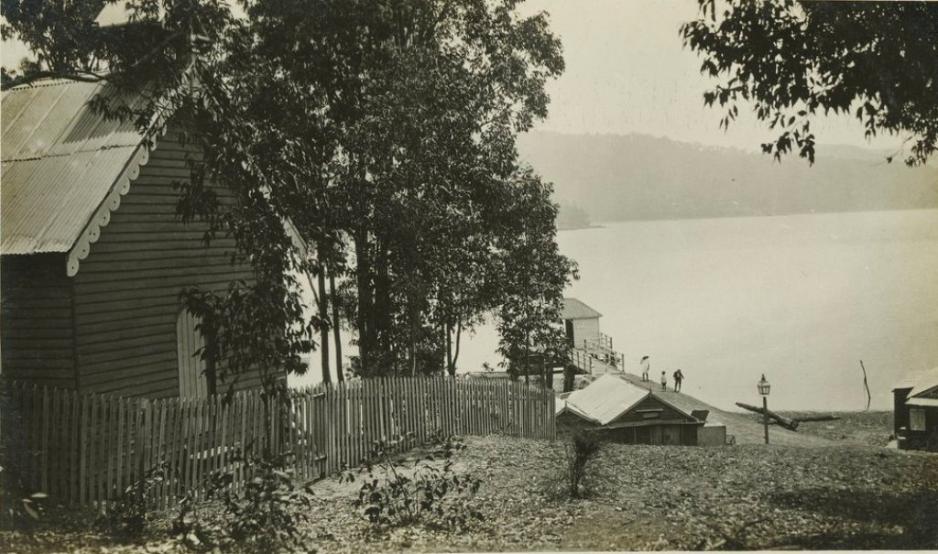
'Church Point, Pitt Water, 20 mins n. from Syd.' by A. J. Vogan (Arthur James), ca. 1910 - ca. 1915, Image H82.254/8/29, courtesy State Library of Victoria.
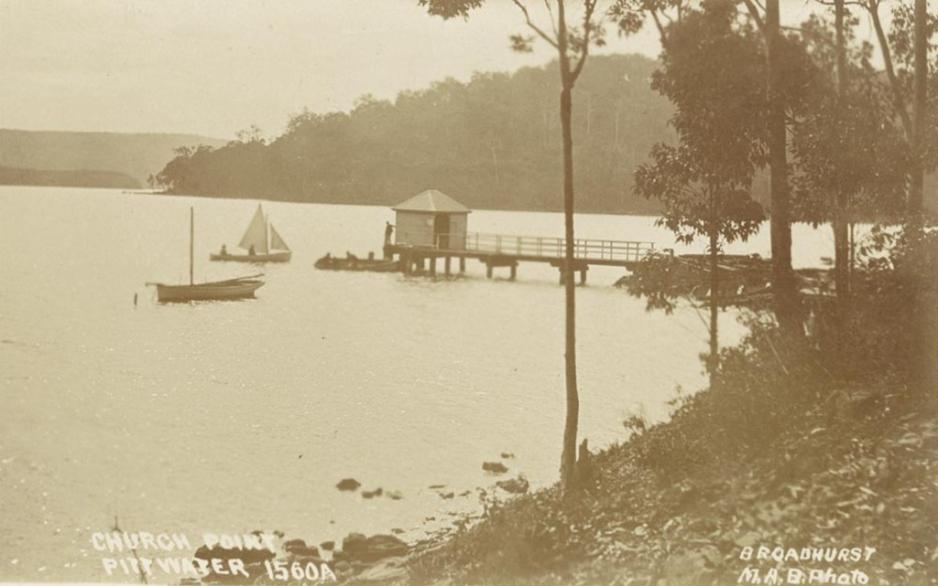
'Church Point, Pittwater'. Digital Order No. a106164 ca. 1900-1927, Sydney & Ashfield : Broadhurst Post Card Publishers. Courtesy State Library of NSW
Church Point Wharf threads collected and collated by A J Guesdon, 2013.
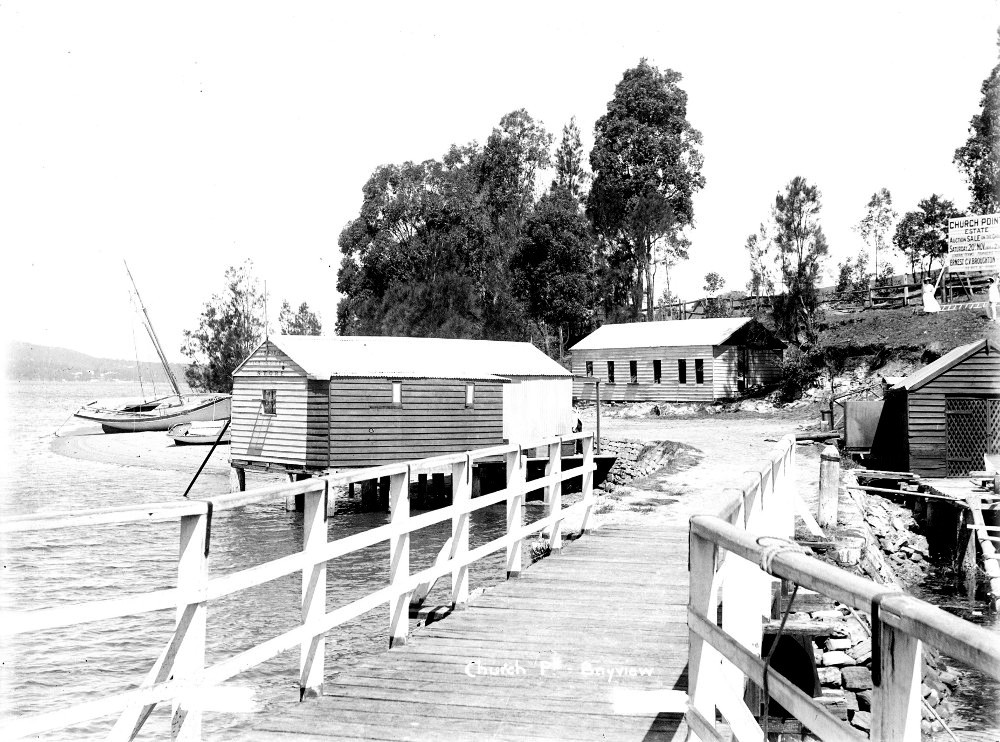
View towards Church Point, Dated: c.1908, Digital ID: 18526_a024_000030, courtesy State Records NSW.

Church Point wharf with Scotland Island in distance. December, 2012. Picture by A J Guesdon.